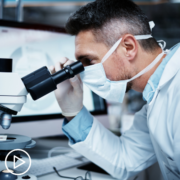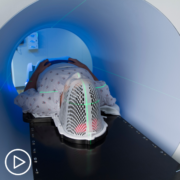Head and Neck Cancer | Key Factors Affecting Treatment Decisions
Head and Neck Cancer | Key Factors Affecting Treatment Decisions from Patient Empowerment Network on Vimeo.
What are key factors that impact head and neck cancer treatment decisions? Expert Dr. Ezra Cohen discusses the role of imaging tests, individual patient factors, and cancer characteristics in making treatment decisions.
See More from Evolve Head & Neck Cancer
Related Resources:

Head and Neck Cancer Research | How Innovation Leads to Advances in Care |

Head and Neck Cancer Clinical Trials | What Are the Benefits? |

|
Transcript:
Katherine:
How is a path decided then or determined for an individual patient? Is there key lab testing that can impact prognosis and treatment options?
Dr. Cohen:
Once a patient comes to the attention of the team, and that will usually be accompanied by some sort of biopsy, some sort of pathological diagnosis to confirm that indeed, we’re dealing with let’s say, squamous cell carcinoma. Then the next thing we want to do is we want to stage the disease. And what that means is basically we want to know as much as possible, or accurately as possible, where the cancer is and how big it is.
So, that would almost always involve scans, usually CT scans, sometimes a PET scan. And we can talk about the advantages and disadvantages of each. Sometimes an MRI in certain situations. But suffice it to say some sort of scan. Some sort of imaging that can tell us where the cancer is, how big it is, if there are any lymph nodes involved and if that cancer has spread beyond the head and neck area.
Once we stage the disease, most patients, and I think certainly most patients should be discussed, their pace, that is, should be discussed at a multidisciplinary tumor board. Where, again, all the specialists convene at the same time, and really go over all the data that are available on that individual and come up with a treatment recommendation.
That treatment recommendation can be a single modality. So, some small tumors can just be addressed by surgery alone, or radiation therapy alone. But, for more advanced tumors, it is often all three modalities: surgery, radiation, and chemotherapy. And the way they’re sequenced, the way they’re implemented, should be individualized for that specific patient. Again, with those two goals in mind: to cure the cancer and to preserve function.
Katherine:
What else could guide a treatment decision? For instance, a patient’s co-morbidity, their age, things like that?
Dr. Cohen:
All of those things.
Katherine:
Yeah.
Dr. Cohen:
So, beyond – and those are things of course that we would consider in the discussion, not only at the tumor board but of course with the patient. We know that the therapy that we often recommend is quite aggressive and toxic.
Now, the justification for that is that we’re going to try to cure the cancer. And, so we think, and of course we discuss this with the patient, that putting the patient through this course of treatment is worthwhile, makes sense, because at the end of it, the goal is for the cancer to be gone. Now, not all patients will agree with that and of course, we, based on comorbidities and age and something we call performance status, we also want to make sure that the patient can get through this aggressive treatment.
Let me just go on a bit of a tangent and describe the therapy for a patient with local advanced head and neck cancer. It would involve about six to seven weeks of radiation, given Monday to Friday. Usually either weekly, or every three-week chemotherapy depending on the chemotherapy chosen.
And possibly even surgery either before or after the combined chemotherapy and radiation. And so, we’re talking about at least a three-month course of treatment going from the start to recovery. Another three months of side effects that are less intense but still there. And it’s a lot for patients to go through. Patients and their caregivers.
And so, if we feel that there’s a serious comorbidity that would not allow the patient to do that, we sometimes have to alter treatment so that obviously, we don’t want to harm the patient with our treatment. Certainly we don’t want to put them in a life-threatening situation. So, we do have to take those things into account. The good thing about all this – or I guess the silver lining, if you will, is that these toxicities get better.
Patients recover. So, what I tell patients is we’re going to put you through hell, but at the end of it, I want to be sitting across from you and saying the cancer is gone, and you’re swallowing, and you’re talking normally.









